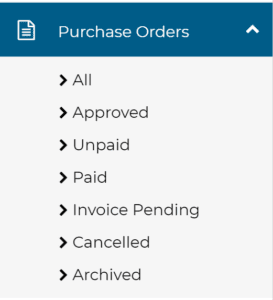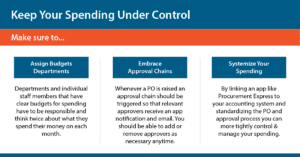The way businesses handle purchasing is evolving. We’re seeing a shift from outdated, manual processes to streamlined systems that turn procurement into a strategic advantage. And at the heart of this transformation is the purchase order management system.
Submitting purchase order documents the old-fashioned way isn’t just inefficient. It’s risky. Without proper purchase controls, budgets spiral, supplier management suffers, and inventory levels become a guessing game. Add in multi-location teams and inept suppliers, and it’s no wonder you can keep the train running on time without the right controls in place.
Ineffective purchase processes can also wreak havoc on your operations, open you up to fraud, and overwhelm your finance team.
With an effective purchase order management system, you can eliminate tedious busy work, improve supplier relationships, and gain control over your spending. Automated approval processes, clear documentation, and real-time visibility empower your team to make smarter decisions, maintain accurate records, and keep your inventory levels optimized.
Let’s dive into why it matters and how to do it right.
- What is Purchase Order Management?
- How Does Purchase Order Management Work?
- The Benefits of Purchase Order Management
- How Does Purchasing Software Improve The Purchase Order Management Process?
- Automated Purchasing Controls Allow for Timely Approvals
What is Purchase Order Management?
Purchase order management is the process of creating, tracking, and managing purchase orders (POs) to ensure smooth and accurate business transactions. A purchase order is a document sent from a buyer to a supplier that outlines the details of a purchase, such as quantity, price, and delivery terms.
For small business owners, purchase order management helps you keep track of what you’ve ordered, avoid overspending, and maintain clear communication with your suppliers. It’s especially useful when dealing with multiple vendors or larger orders, as it provides a paper trail that can prevent miscommunication or disputes.
By using tools like purchase order management software designed for purchase order management, you can automate many manual processes, save time, and focus on growing your business instead of juggling paperwork.
How Does Purchase Order Management Work?
The purchase order process is all about creating a clear, binding document that outlines exactly what your business is buying. Here’s how it works step by step:
- Create the purchase order: Draft a purchase order (PO) with all the key details—item descriptions, quantities, prices, payment terms, and delivery dates.
- Send to the supplier: Share the PO with your supplier to confirm the order details. This step ensures both sides are aligned and establishes the PO as a binding document.
- Supplier approval: The supplier reviews and approves the PO, moving the process forward while creating an audit trail for future reference.
- Order fulfillment: The supplier ships the items as outlined in the PO, keeping everything on track for delivery.
- Receive and inspect goods: Check the delivered items against the PO to verify quality and accuracy before accepting them.
- Invoice and payment: The supplier submits an invoice, and your accounts payable team processes payment in line with the agreed-upon payment terms.
- Recordkeeping: Use procurement or purchasing software to save purchase requests, POs, invoices, and approvals for compliance and better financial accounting.
The Benefits of Purchase Order Management
Streamlined Purchases
Tight purchasing policies are the key to controlling spend and improving better record-keeping. To get started, you’ll need to define your preferred purchasing methods clearly.
Who on your team has the authority to purchase? Will there be any limitations on spending?
Which vendors are you using and how do you determine who you should be working with?
Beyond price, you’ll need to develop a process for choosing a vendor. Be mindful of which suppliers make the preferred list and set limits within your system. Buying from the same few vendors will potentially open you up to better deals, discounts, and agreeable terms.
Reduce Fraud
No one wants to believe that any of their staff are stealing from the company, but that doesn’t mean you can skip protections. Adding purchase controls to your procurement process means all POs are routed to the right person, so no extra orders slip through the cracks.
You’ll quickly be able to shut down unauthorized spending, while the added controls make things easier for employees.
The purchasing process could look something like the below example from SmartDraw—it’s not the prettiest example, but this serves as a good starting point for the approval control process.
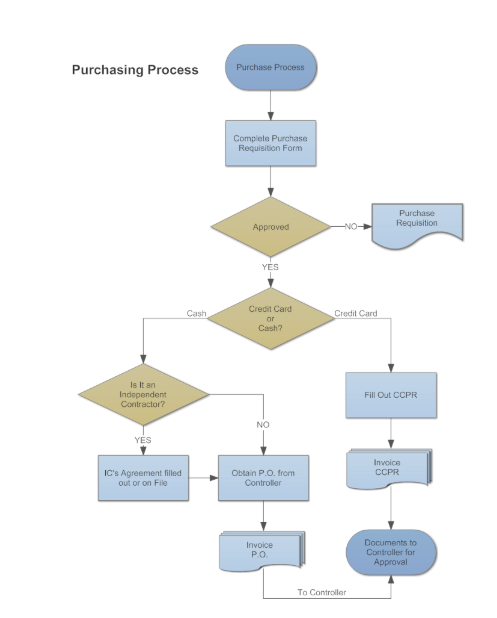
Eliminates Paperwork
Rather than wasting time searching for the right documents—automating the end to end ordering process means that all data is stored safely in the cloud.
In fact, GovTech recently published an article citing a loyalty to paper POs is one of the top three technology gaps facing procurement.
Approval workflow automation is about bringing efficiency and control to the table. Adding the right software to your procurement process ensures that outgoing orders are error-free, stored in the cloud, and protected against fraud and costly mistakes.
Additionally, automating what was once the domain of detail-oriented employees minimizes the risk of human error. Processing POs and Sales Orders can be a repetitive process that requires significant attention to detail. This means, double, triple, quintuple checking to ensure all documents match up.
By automating the PO process and setting purchase controls, you’re reducing the time spent trying to account for misentered orders and cutting down on the potential for mistakes.
The idea is, humans are communicators and creators—and even in a field like procurement, it makes more sense to spend most of your time on strategy. Less paperwork means you’ll free up time for relationship-building and strategic budgeting and sourcing.
Improves Delivery Times
With faster technology at our fingertips, there’s an increased expectation that orders are received as fast as possible. Businesses need to be able to quickly respond to order requests and get items out often that same day.
With purchase order controls in place, you’ll have a digital record of everything, and orders will be guaranteed to come from a list of approved suppliers. This means that terms and turnaround times are predictable—and you’re not left in a lurch waiting for items ordered from an unproven source.
Additionally, controls give managers the ability to view the status of all orders and pay invoices on time—ensuring no shipping delays caused by failure to pay.
Make Better Decisions
Data is the backbone of decision-making. A supply chain system can deliver mission-critical information in real-time to improve decision making and avoid costly mistakes.
As we enter what PwC dubs Procurement 4.0, having all insights available at our disposal makes for a more efficient procurement department.
While the below diagram refers to the procurement process as a whole, the ability to quickly process orders and accelerate the buying cycle stands to have a huge impact on the department and the entire organization.
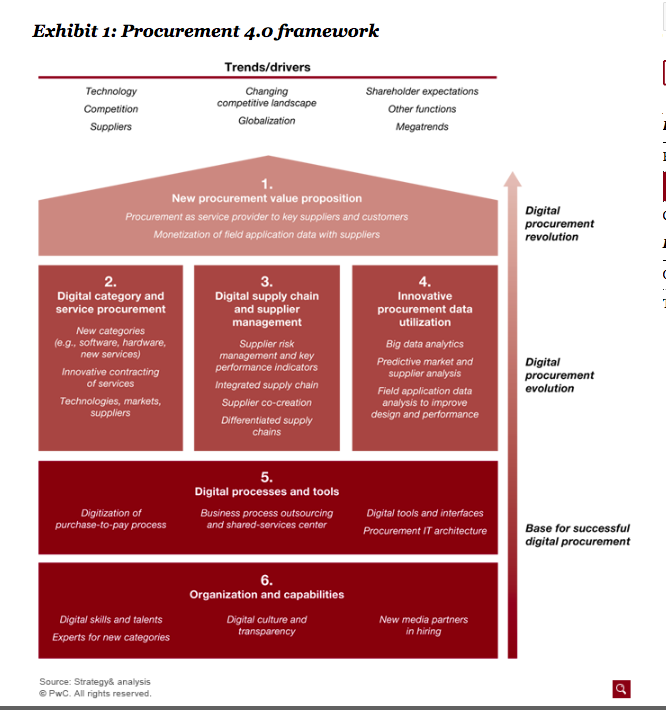
Greater Visibility
Recording purchase orders in your system allows you to have cost and order information at your fingertips. View costs without waiting for an invoice and look through your records to tailor your budget to meet more realistic goals.
Increased visibility means access to more data—thus bringing us back to the strategic role of procurement. Without automation, teams are left manually plugging in data, wasting valuable time searching for records or creating reports by hand.
When systems don’t talk to each other, you’re missing out on status notifications, easy access to reports, and the ability to forecast.
As a business owner or manager, your job is to oversee the whole operation, and adding clear-cut controls into the purchasing process makes it easier to pass off the purchasing responsibilities to another person on your team.
With our software, you can route the system, so the buck stops with you. You’ll receive a notification when a PO is created, and you can review and approve with the touch of a button.
You’ll still have control over things like vendor selection, quality control, and so on, but you can rest assured workflows will prevent costly mistakes.
In this chart sourced from McKinsey, you can see that digitizing procurement processes–like PO controls–leads to increased improvements across the board. Essentially, digitizing processes like ordering and relationship management frees up time for critical thinking.
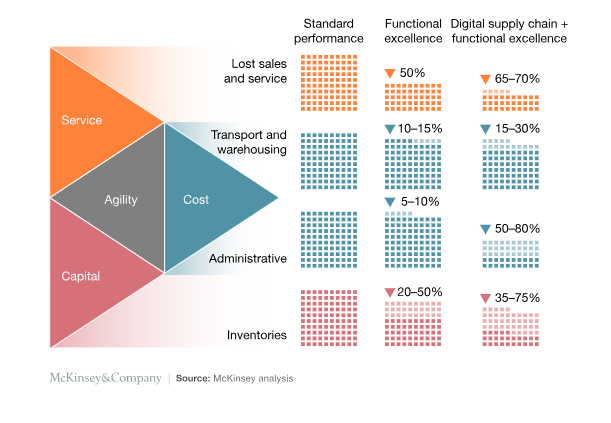
How Does Purchasing Software Improve The Purchase Order Management Process?
Purchasing software takes the hassle out of the purchase order approval process by automating manual processes and reducing the risk of errors. It streamlines everything from submitting purchase requests to the approval process.
Without purchasing software, relying on manual processes can lead to costly errors like duplicate orders, misplaced documents, or missed payment terms. These issues disrupt supplier relationships, create inefficiencies in the approval process, and burden your accounting department with unnecessary troubleshooting.
Manual methods also make it harder to keep accurate records and maintain financial control, which can impact your bottom line.
Procurement software fixes this by centralizing records, improving accountability, and reducing the workload for your accountant or accounting team. It provides the tools to manage purchases efficiently, minimize costly errors, and maintain clear audit trails.
Automated Purchasing Controls Allow for Timely Approvals
Some approvers suffer from decision fatigue and postpone approving any purchase order activity they have any doubts over. This leaves the requester powerless, waiting on the green light from the approver.
When you automate the ordering process, approvers receive email or push notifications that gently remind them that pending orders are waiting in the wings.
Making the switch to digital means that approvers can view records of which orders are pending and which orders have been submitted.
What’s more–having a list of approved vendors in the system cuts down on unnecessary or incorrect orders. As the approver, your job becomes streamlined, and you’ll have fewer status-related questions filling up your inbox.
Parting Thoughts
Efficient purchase order controls ultimately allow businesses to keep a close eye on standarized purchases, budgets and plan spending well in advance.
With the right software, you stay on top of spend, make fewer mistakes, and have a policy that clarifies the rules for everyone. When policies are documented and implemented, everyone knows how to play by the rules.
We’ve certainly made the case for taking your procurement process into the digital era. Swap out your spreadsheets for something more flexible. Contact ProcurementExpress.com to get started with our software.

